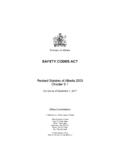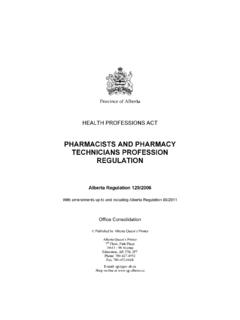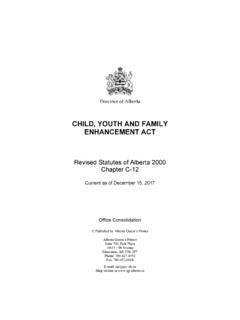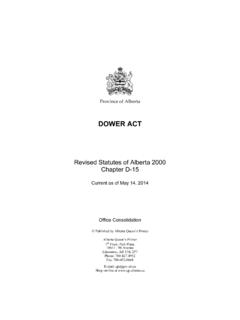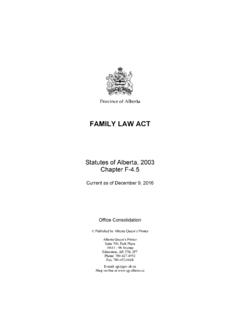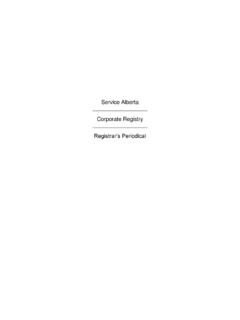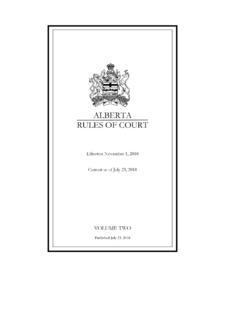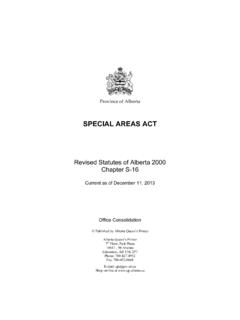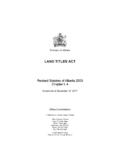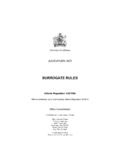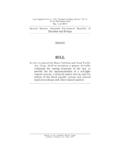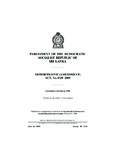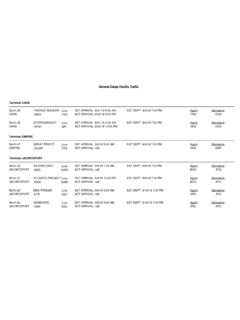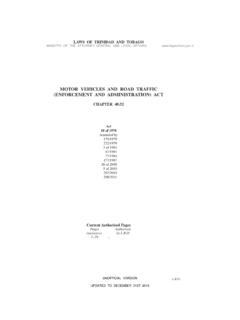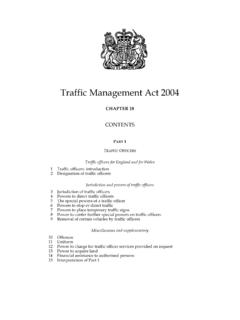Transcription of TRAFFIC SAFETY ACT - Alberta
1 Published by Alberta Queen s Printer E-mail: Shop on-line at Alberta Queen s Printer Suite 700, Park Plaza 10611 - 98 Avenue Edmonton, AB T5K 2P7 Phone: 780-427-4952 Fax: 780-452-0668 Province of Alberta Office Consolidation Alberta Regulation 121/2009 With amendments up to and including Alberta Regulation 222/2020 Current as of January 1, 2021 TRAFFIC SAFETY ACT COMMERCIAL VEHICLE SAFETY REGULATION Copyright and Permission Statement Alberta Queen's Printer holds copyright on behalf of the Government of Alberta in right of Her Majesty the Queen for all Government of Alberta legislation. Alberta Queen's Printer permits any person to reproduce Alberta s statutes and regulations without seeking permission and without charge, provided due diligence is exercised to ensure the accuracy of the materials produced, and Crown copyright is acknowledged in the following format: Alberta Queen's Printer, 20__.
2 * *The year of first publication of the legal materials is to be completed. Note All persons making use of this consolidation are reminded that it has no legislative sanction, that amendments have been embodied for convenience of reference only. The official Statutes and Regulations should be consulted for all purposes of interpreting and applying the law. (Consolidated up to 222/2020) Alberta REGULATION 121/2009 TRAFFIC SAFETY Act COMMERCIAL VEHICLE SAFETY REGULATION Table of Contents Interpretation 1 Definitions General Standards 2 Adoption of standards Prohibition 3 Operating an unsafe vehicle Compliance with SAFETY Standards 4 Compliance with SAFETY standards Mobile treatment centre module Compliance with Maintenance Standards 5 Compliance with maintenance standards 6 Maintenance and inspection program 7 Corrective actions 8 Notice of defect Trip Inspection Requirements 9 Definitions 10 Daily trip inspection requirements 11 Under-vehicle trip inspection requirements 12 Trip inspection report 13 Distribution and retention of reports 14 Report of defects 15 Defects observed during operation 16 Requirements to repair or correct Cargo Securement Requirements 17 Cargo securement requirements AR
3 121/2009 COMMERCIAL VEHICLE SAFETY REGULATION 2 School Bus Operation Requirements 18 Compliance with standards 19 Limitation on use of school bus 20 Requirements for other use of school bus 21 Vehicle no longer used as a school bus 22 Alteration of school bus 23 Prohibitions 24 Fuelling 25 Use of tobacco, etc. 26 Embarking and disembarking students 27 Application of crossing arm outside of urban area 28 Application of crossing arm inside urban area 29 Standing, etc., in school bus 30 Leaving school bus Driveaway or Towaway Requirements 31 Driveaway or towaway requirements Transportation of Anhydrous Ammonia Requirements 32 Transportation of anhydrous ammonia and other fertilizers 33 Brakes on trailer 34 Brakes on trailers not required 35 Farm wagon trailer 36 Self-propelled floater implement of husbandry Records 37 Records 38 Retention of records 39 Interference with records Administration 40 Exemption by Registrar 41 Notice of administrative penalty 42 Determination of penalty amount 43 Limitation period 44 Offences Transitional Provisions, Consequential Amendments, Repeals.
4 Expiry and Coming into Force 45 Transitional provisions Section 1 AR 121/2009 COMMERCIAL VEHICLE SAFETY REGULATION 3 46-48 Consequential amendments 49 Repeals 51 Coming into force Schedules Appendix Interpretation Definitions 1(1) In this Regulation, (a) Act means the TRAFFIC SAFETY Act; (b) bus means a bus as defined in section 130(1)(a) of the Act; (c) carrier means a carrier as defined in section 130(1)(b) of the Act; (d) handi-bus means a handi-bus as defined in the Vehicle Inspection Regulation (AR 211/2006); (e) motor coach means a bus of monocoque design manufactured with underfloor baggage storage, but does not include a transit bus; (f) notice of defect means a notice issued by a manufacturer, distributor or importer of a vehicle as prescribed by the Motor Vehicle SAFETY Act (Canada); (g) owner means owner as defined in section 1(1)(ee) of the Act; (h) principal place of business means a principal place of business of a carrier as defined in the Drivers Hours of Service Regulation (AR 317/2002); (i) school means (i) a charter school as defined in section 1(1)(e) of the Education Act, or (ii) a school as defined in section 1(1)(x)(i), (ii) or (iv) of the Education Act; (j) school board means (i) a board as defined in section 1(1)(c) of the Education Act, or Section 2 AR 121/2009 COMMERCIAL VEHICLE SAFETY REGULATION 4 (ii) a person or organization that operates a private school as defined in section 1(1)(t) of the Education Act.
5 (k) school bus means a bus that meets the requirements of a Type A1, A2, B, C or D school bus described in CSA-D250-16, or a version of CSA-D250 applicable at the time of manufacture, and that is used primarily to transport students to and from school, but does not include a Multifunction School Activity Bus as described in CSA-D250-16; (l) student means a student as defined in section 1(1)(hh) of the Education Act; (m) transit bus means a transit bus as defined in the Vehicle Inspection Regulation (AR 211/2006). (2) In this Regulation, retrofit and retrofitted do not include the replacement or addition of parts or equipment to rectify a defect in a vehicle in respect of which a manufacturer has issued a recall. AR 121/2009 s1;78/2013;98/2017;81/2019 General Standards Adoption of standards 2 The following standards are adopted and apply to commercial vehicles under this Regulation: (a) Canadian Standards Association Standard CAN/CSA B651, referred to as CAN/CSA B651, as it applies to signs and accessibility symbols; (b) Canadian Standards Association Standard D250-16, referred to as CSA-D250-16, as amended or replaced from time to time, as it applies to school buses; (c) Canadian Standards Association Standard Z605, referred to as CSA Z605, as it applies to mobility aids and MASOR systems; (d) Canada Motor Vehicle SAFETY Standard 209 Seat Belt Assemblies, referred to as CMVSS 209, as it applies to seat belt assemblies; (e) Canada Motor Vehicle SAFETY Standard 210 Seat Belt Assembly Anchorages, referred to as CMVSS 210, as it applies to seat belt assembly anchorages.
6 Section 3 AR 121/2009 COMMERCIAL VEHICLE SAFETY REGULATION 5 (f) National SAFETY Code for Motor Carriers Standard 10 (Cargo Securement), referred to as NSC Standard 10, made by the Canadian Council of Motor Transport Administrators and dated June 2013, as amended from time to time, section 1 (Interpretation) and Parts 1 to 4; (g) National SAFETY Code for Motor Carriers Standard 13, Part 2 (Trip Inspection), made by the Canadian Council of Motor Transport Administrators, referred to as NSC Standard 13, as follows: (i) Schedule 1 (Truck, Tractor and Trailer), (ii) Schedule 2 (Bus), (iii) Schedule 3 (Motor Coach - Daily), (iv) Schedule 4 (Motor Coach - 30 Days or 12 000 Kilometres); (h) Society of Automotive Engineers Standard J774, referred to as SAE J774, as it applies to emergency warning devices; (i) Society of Automotive Engineers Standard J941, referred to as SAE J941, as it applies to visibility standards for school bus drivers; (j) Underwriters Laboratory of Canada Standard CAN-ULC-S508-M, referred to as CAN-ULC-S508-M, as it applies to rating and testing of fire extinguishers.
7 AR 121/2009 s2;78/2013;60/2016;98/2017 Prohibition Operating an unsafe vehicle 3 In addition to any other requirements of this Regulation and the Schedules to this Regulation, a person shall not operate or permit another person to operate a commercial vehicle on a highway if the commercial vehicle or any equipment pertaining to the commercial vehicle is in a condition that is likely to cause danger to persons or property. Compliance with SAFETY Standards Compliance with SAFETY standards 4(1) Unless otherwise provided in this Regulation or a Schedule to this Regulation, a person shall not operate or permit another person to operate a commercial vehicle on a highway unless the Section AR 121/2009 COMMERCIAL VEHICLE SAFETY REGULATION 6 commercial vehicle complies with the SAFETY standards set out in Schedule 1. (2) A person shall not modify, retrofit or otherwise equip a commercial vehicle in such a way or to such an extent that it no longer complies with the applicable standards referred to in this section and in section 5.
8 (3) Subsection (2) and the provisions of Schedule 1 shall not be construed so as to require a school bus to be retrofitted with any equipment if that equipment was not originally included in that bus when it was manufactured, as long as the bus conformed with the version of CSA D250 applicable at the time of manufacture. Mobile treatment centre module (1) In this section and in Schedule 8, mobile treatment centre module means an attached compartment on a commercial vehicle that is used to provide first aid and medical assistance and to transport injured or ill workers. (2) A person shall not operate or permit another person to operate a commercial vehicle equipped with a mobile treatment centre module on a highway with passengers in the mobile treatment centre module unless the commercial vehicle complies with the SAFETY standards set out in Schedule 8. AR 128/2020 s2 Compliance with Maintenance Standards Compliance with maintenance standards 5(1) In this section and in section 6 and Schedule 2, commercial vehicle means (a) a commercial vehicle or a combination of commercial vehicles that is registered for a gross weight of more than 4500 kilograms and that is not a bus, or (b) a bus.
9 (2) Unless otherwise provided in this section or in Schedule 2, a person shall not operate or permit another person to operate a commercial vehicle on a highway unless the commercial vehicle complies with the standards (a) prescribed in Schedule 2, (b) prescribed under the Vehicle Equipment Regulation, and (c) required under Section 6 AR 121/2009 COMMERCIAL VEHICLE SAFETY REGULATION 7 (i) the Motor Vehicle SAFETY Act (Canada), and (ii) the Motor Vehicle SAFETY Regulations (Canada) applicable at the time of manufacture of the vehicle. (3) In addition to the requirements of subsection (2), a person shall not operate or permit another person to operate a bus that is equipped to transport persons with physical disabilities on a highway unless the vehicle complies with the standards prescribed in Schedule 3. (4) In addition to the requirements of subsections (2) and (3), a person shall not operate or permit another person to operate a handi-bus on a highway unless the vehicle complies with the standards prescribed in Schedule 4.
10 (5) In addition to the requirements of subsection (2), a person shall not operate or permit another person to operate a school bus on a highway unless the vehicle complies with the standards prescribed in (a) Schedule 5, and (b) the requirements of CSA-D250-16 as adopted by section 2(b). (6) Despite subsections (2), (3), (4) and (5), if the manufacturer of a commercial vehicle constructs a vehicle to standards that are different from any of the requirements under subsection (2), (3), (4) or (5), as the case may be, a person shall not operate or permit another person to operate that vehicle on a highway unless that vehicle is maintained to those different standards. (7) Subsection (4) does not apply to a handi-bus that was purchased or first used as a handi-bus before September 1, 1999. (8) Subsections (1) to (5) and the provisions of Schedules 2 to 5 shall not be construed so as to require a school bus to be retrofitted with any equipment if that equipment was not originally included in that bus when it was manufactured, as long as the bus conformed with the version of CSA D250 applicable at the time of manufacture.
